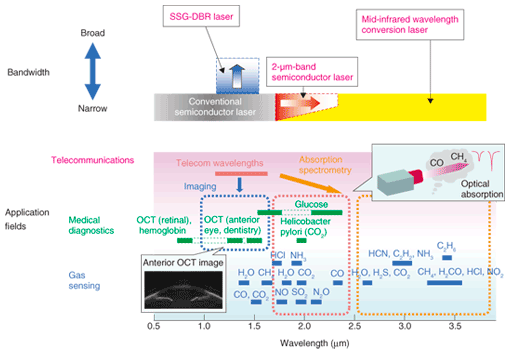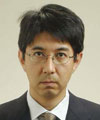 |
|||||||||||||
|
|
|||||||||||||
|
Special Feature: Light Source Technologies for Sensing Applications Vol. 7, No. 1, pp. 5–8, Jan. 2009. https://doi.org/10.53829/ntr200901sf1 Light Source Technologies for Sensing ApplicationsAbstractNTT Photonics Laboratories has developed laser sources that are small and inexpensive and have low power consumption as well as excellent wavelength controllability for the construction of a sophisticated low-cost telecommunications system. These features are the keys to achieving high-performance systems and devices for applications even beyond the telecommunications field. The newly developed laser sources, which are introduced in this special issue, provide excellent levels of performance that cannot be achieved with the conventional optical sources used for sensing devices in the fields of environmental measurement and medical diagnosis.
1. Sensing applications of telecommunications light sourcesSociety°«s concerns about security and safety have recently increased, so demand has arisen for sensing technology that can measure our living environment and health conditions promptly and accurately. In this respect, optical sensing has attracted attention as an advanced instrumentation technology that can provide high-speed, highly sensitive measurements without the need to sample the target object. In addition, the laser has recently been studied as an optical source with a view to achieving improved characteristics. In response, NTT Photonics Laboratories has utilized design and fabrication techniques devised in developing laser sources for communications to design optical sources for sensing during environmental measurements and medical diagnoses. The laser sources developed for optical communications are small and inexpensive and have low power consumption. In addition, they offer excellent wavelength controllability, so they should be able to improve the efficiency of systems and devices used in other fields [1]. The positioning of the newly developed light sources for sensing applications is shown in Fig. 1. There are two approaches that are characteristic of laser sources designed to improve the performance of sensing devices.
One involves extending the emission wavelength. The optical gas sensing technique determines the kind and concentration of target molecules from the wavelength and intensity of their optical absorption. Therefore, highly sensitive high-speed measurement becomes possible by using strong optical absorption. In general, the optical absorption of a molecule tends to increase at longer wavelengths. As a result, it is important to lengthen the emission wavelength when making a highly sensitive sensing device. NTT Photonics Laboratories has developed two kinds of laser sources with the goal of extending the wavelength. One is a strained-layer InAs quantum-well laser emitting at 2.3 µm [2], which was achieved by optimizing the growth technique. The other is a mid-infrared wavelength conversion laser consisting of two high-power semiconductor lasers and a highly efficient nonlinear optical crystal that utilizes a novel fabrication technology [3], [4]. The other approach involves expanding the tuning wavelength range. Recently, optical coherence tomography (OCT) has been attracting attention for imaging sensor applications. OCT is a noninvasive in-vivo imaging technique. An optical source with a wide wavelength bandwidth has already been used for OCT, and we can expect the resolution capability and scanning speed to be improved by using a tunable laser. NTT Photonics Laboratories has also developed a wideband tunable laser, namely the superstructure grating distributed Bragg reflector laser [5]. The technical characteristics and features of these three newly developed laser sources are described in detail in other articles in this special issue. Below, we briefly mention their features and applications. 2. Strained-layer InAs quantum-well laser emitting at 2.3 µmSemiconductor lasers used for optical communications emit at a wavelength of 1.3 or 1.55 µm, so the propagation loss in the optical fiber is small. However, to achieve a highly sensitive sensing device it is important to extend the emission wavelength, as stated above. For example, the optical absorption intensity of CO at 2.3 µm is about two orders of magnitude stronger than that at 1.5 µm. To lengthen the emitting wavelength, we must change the composition of the quantum well layer used as the active layer. However, when the composition is changed, strain is induced in the semiconductor layer. Furthermore, when the wavelength exceeds 2 µm, the strain in the quantum well layer exceeds the allowable limit, crystal defects are generated, and lasing become difficult. We have overcome this material limitation in the developed semiconductor laser by optimizing the growth condition, and we have achieved an emission wavelength of 2 to 2.3 µm in a small laser with low power consumption, which are the features of the optical communications laser. In this wavelength range, there is strong light absorption by CO2, N2O, and CO. As a result, these lasers enable highly sensitive realtime monitoring of environmental gases. Moreover, we expect that these lasers will find medical applications as optical sources in the urea breath test system used for the diagnosis of Helicobacter pylori and in optical blood glucose level sensors. 3. Mid-infrared wavelength conversion laserThis mid-infrared light source is based on the wavelength conversion of laser diodes. It consists of a quasi-phase matched LiNbO3 (QPM-LN) waveguide and two pump laser diodes. New waveguide fabrication technology enabled us to achieve efficient difference frequency generation in the mid-infrared wavelength range. The waveguide is packaged in a fiber pigtailed module, thus allowing us to construct a compact mid-infrared light source. This product can emit a continuous wave output in the 3-µm band at room temperature. Output power of 0.2 mW can be generated without the need for a high-power solid-state laser or a high-power fiber amplifier. In this wavelength range many hydrocarbon gases (e.g., methane and ethane) exhibit strong absorption. Therefore, this laser will be suitable for detecting such gases. By changing the waveguide design and combining two laser diodes, we can use this technology to cover a wavelength range of up to 5 µm. If we scan the driving current of one of the pump lasers, the output wavelength can be scanned over the gas absorption lines. These compact mid-infrared lasers are promising for use in highly sensitive, realtime, in-situ measurement systems for various gases. 4. Superstructure grating distributed Bragg reflector (SSG-DBR) laserTunable lasers have been developed for wavelength-division-multiplexing (WDM) network systems. In particular, the SSG-DBR laser offers wide wavelength tuning and fast wavelength switching. The lasing wavelength can be electrically controlled by changing the refractive index by means of the carrier plasma effect in the passive DBR reflector. The switching time is expected to be of the microsecond order. The optical frequency domain reflectometry optical coherence tomography (OFDR-OCT) system is attractive for application as a medical sensing light source. It provides a noninvasive and noncontact technique for obtaining high-resolution images in, for example, ophthalmologic examinations for glaucoma, dental examinations, skin examinations, and endoscopy. Producing high-resolution graphics requires a high scanning speed and a wide tuning range. The features of the SSG-DBR laser meet these demands. In addition, single-mode lasing has the merit of providing a high-coherence optical measurement system. We have developed four kinds of light sources that achieve a tuning range of 143 nm. We also improved the thermal drift and achieved fast scanning within 350 ms in this 143-nm tuning range. These light sources are currently candidates for use in OFDR-OCT. 5. ConclusionNTT Photonics Laboratories has developed new optical sources for sensing by utilizing optical communications source technology. We are convinced that these laser sources, which grew out of optical sources designed for communications use, will provide new impetus to the fields of environmental monitoring and medical diagnosis and help to meet society°«s desire for security and safety. References
|
|||||||||||||











